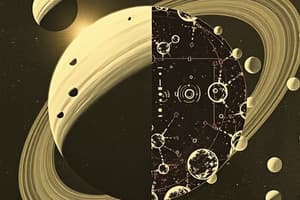Podcast
Questions and Answers
K2-18b gezegeninin atmosferinde hangi karbon taşıyan moleküllerin varlığı keşfedilmiştir?
K2-18b gezegeninin atmosferinde hangi karbon taşıyan moleküllerin varlığı keşfedilmiştir?
- Metan ve karbon dioksit (correct)
- Karbonmonoksit ve hidrojen
- Nitrojen ve karbonat
- Su buharı ve azot dioksit
K2-18b'nin yarıçapı Dünya'nın kaç katıdır?
K2-18b'nin yarıçapı Dünya'nın kaç katıdır?
- 4.2
- 3.5
- 1.8
- 2.6 (correct)
Hangi kavram, K2-18b'nin potansiyel yaşama destek olup olmadığı konusunda kesin bir garanti vermez?
Hangi kavram, K2-18b'nin potansiyel yaşama destek olup olmadığı konusunda kesin bir garanti vermez?
- Astronomik zon
- Habitabl olma
- Ekzosfer
- Yaşanabilir bölge (correct)
K2-18b'nin içinde bir Neptün'e benzer bir yapıya sahip olduğu belirtilmektedir. Bu yapıda hangi gaz daha az yoğunluktadır?
K2-18b'nin içinde bir Neptün'e benzer bir yapıya sahip olduğu belirtilmektedir. Bu yapıda hangi gaz daha az yoğunluktadır?
Araştırmacılar K2-18b'nin bir Hycean dünya mı yoksa bir Mini-Neptün senaryosuna mı daha yakın olduğunu tartışmaktadır. Mini-Neptün senaryosunda gezegen hangi özelliğe sahiptir?
Araştırmacılar K2-18b'nin bir Hycean dünya mı yoksa bir Mini-Neptün senaryosuna mı daha yakın olduğunu tartışmaktadır. Mini-Neptün senaryosunda gezegen hangi özelliğe sahiptir?
K2-18b'nin yrnge sresi ne kadar?
K2-18b'nin yrnge sresi ne kadar?
Habitabilite blgesi neyi ifade eder?
Habitabilite blgesi neyi ifade eder?
K2-18b'nin atmosferinde ne tr bir gaz olabilecei nerilmitir?
K2-18b'nin atmosferinde ne tr bir gaz olabilecei nerilmitir?
Sub-Neptnler hangi zellikleri sergiler?
Sub-Neptnler hangi zellikleri sergiler?
Exoplanetlerin genel olarak zellikleri neler arasnda deiir?
Exoplanetlerin genel olarak zellikleri neler arasnda deiir?
Flashcards are hidden until you start studying
Study Notes
K2-18b: A Sub-Neptune in the Habitable Zone
K2-18b is a sub-Neptune exoplanet located in the habitable zone of its host star, K2-18. With an orbital period of 33 days, it receives about the same amount of energy from its dim red dwarf star as Earth does from our Sun. This makes it an intriguing object for astrobiologists and planetary scientists studying potential life beyond our solar system.
The Habitable Zone
The term "habitable zone" refers to a region around a star where planets receive the right balance of heat to potentially support liquid water on their surfaces. For a planet like K2-18b to be considered within this zone, it must maintain conditions that are neither too hot nor too cold for water to exist in a liquid state. In the case of K2-18b, observations with NASA's Hubble Space Telescope suggested that it could possess a hydrogen-rich atmosphere and a water ocean-covered surface.
Exoplanets and Planetary Habitability
Exoplanets are celestial bodies orbiting stars outside our own solar system. They come in various sizes and compositions, ranging from rocky worlds similar to Earth to gas giants like Jupiter. K2-18b falls into the category of sub-Neptunes, which have masses between those of Earth and Neptune but do not resemble any known planets in our Solar System. These planets pose unique challenges for astronomers trying to understand their properties and potential habitability.
Characterizing K2-18b
Recent studies using data from the James Webb Space Telescope (JWST) have revealed the presence of carbon-bearing molecules such as methane and carbon dioxide in K2-18b's atmosphere. While these findings suggest that the planet lies within the habitable zone, they do not guarantee that it can support life. K2-18b has a radius 2.6 times that of Earth and is estimated to contain a Neptune-like interior with a thinner hydrogen-rich atmosphere and an ocean surface. Hycean worlds, predicted to have oceans of water, could potentially host life, but it remains uncertain whether K2-18b's ocean is habitable due to factors like temperature and pressure.
Debating Hycean Worlds vs. Mini-Neptunes
Some researchers argue that K2-18b might be a hycean world, possessing a large hydrogen-rich atmosphere covering a deep liquid water ocean. Others favor the idea of a mini-Neptune scenario, where the planet lacks a solid surface entirely and would be challenging to maintain stable temperatures without the influence of a biosphere or some unknown process. These interpretations highlight the ongoing scientific debate surrounding the nature of exoplanets and their potential habitability.
Studying That Suits You
Use AI to generate personalized quizzes and flashcards to suit your learning preferences.




